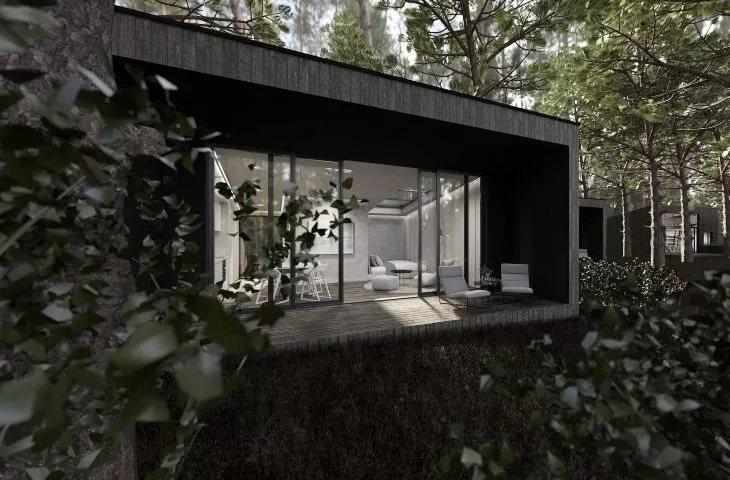Modern houses are multifunctional structures - they are at the same time an office, an exercise area, a playground and a space for recreation. They are becoming larger and larger, providing their residents with convenience. But is it possible to have all this, but in a much smaller space? A space that won't leave such a big mark on the environment? The TINY HOUSES project by Marta Węzik seeks to answer this question.
The slogan less is more fully captures the concept of the Tiny House movement. It focuses on the celebration of simple and resourceful living. Houses according to this concept can be designed to have maximum usable space with minimum built-up area.
The author opted for a dark wood facade
© Marta Węzik
TINY HOUSES by Marta Węzik was created at the University of Arts in Poznań in the Ecological Design Studio led by Natalia Kliśko-Walczak, PhD. The student designed four houses placed on a wooded building plot near Warsaw. Conditions for the development of a residential building were issued for the site and a development area covering thirty percent of the plot was established. An important aspect for the author was to develop the site in such a way that not a single tree was removed. The large plot area of 2866 square meters made it possible to design four houses for people who promote an ecological way of life and minimalism.
plan of a one-story house
© Marta Węzik
The project included two types of buildings - square-plan and rectangular with a mezzanine. Each of these houses is fully equipped and functional, and does not exceed an area of 35 square meters. The first of the proposed buildings is one-story. The simple division allowed the author to set up an entrance area, a bathroom, a kitchen and a living area with a bedroom. A sizable space for storage and a terrace has also been set aside. Large windows open the small house to the surrounding landscape and bring natural light into the interiors.
The bright interior of the one-story house
© Marta Węzik
The second type of house, much taller than the previous one, was designed on a rectangular plan with a small mezzanine on which a bedroom is located. The entrance area and toilet were placed directly below it. In order not to waste space, the author introduced furniture buildings for the entire height of the building.
The second type of building has bedrooms on a mezzanine and high furniture development
© Marta Węzik
In addition to large glazing, the character of the interiors is added by ladders, which make it possible, to get to the higher parts of the furniture development and the mezzanine. Also this building is equipped with a terrace, which increases the usable area of the house on sunny days.
Light comes in through an additional skylight in the roof
© Marta Węzik
It also became the student's goal to blend the houses into the forest surrounding the plot. Hence the decision for dark, wooden facades and a simple body. The contrast is provided by the interiors, dominated by warm, broken white, which brightens up the space (the buildings, due to the nature of the site, will be rather shady). The author also used natural clay plaster, as well as light wood and furniture board to break the severity of the materials.
Also read about the INANI container house project by Kai Bursa.












































